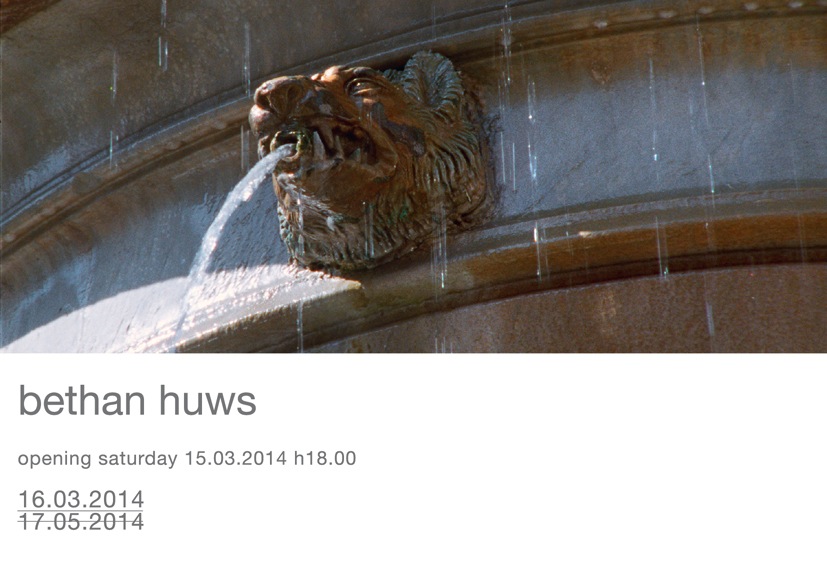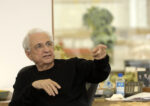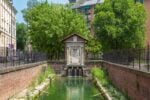Bethan Huws

Le opere in esposizione raccontano, nella diversità degli approcci utilizzati, come Bethan Huws, artista concettuale, sia in realtà difficilmente riconducibile a schemi rigidamente predefiniti. Maestra dei ready-made, sulla scia che fu di Duchamp così come di Piero Manzoni, guarda anche allo stupefacente lavoro intellettuale di Magritte.
Comunicato stampa
Bethan Huws (Bangor 1961) è un’artista gallese che, dopo la formazione scolastica a Londra, vive tra Parigi e Berlino.
Il suo lavoro è fortemente influenzato dalle origini geografiche, dall’infanzia trascorsa in una fattoria e dal fatto che sua madre lingua sia il gallese, lingua celtica assai diversa dall’inglese, parlata da una ristretta minoranza.
La sua è arte concettuale che si inserisce nel percorso pioneristico avviato da Marcel Duchamp, tra i primi a utilizzare il linguaggio come elemento fondante della creazione artistica e i giochi di parole come tecniche non-sense per investigare affondo l’essenza stessa dell’oggetto d’arte.
L’idea della traducibilità delle diverse lingue così come un’educazione prettamente rurale sono il caposaldo del pensiero di Huws, che utilizza da sempre i mezzi più disparati per esprimere la propria personalissima visione del mondo.
La sua poetica investiga con costante arguzia e ironia, non disgiunte da una leggerezza tipicamente britannica, l’essenza stessa del fare arte. Nel tentativo di giungere alla natura primigenia di ogni manufatto, l’artista si interroga e ci interroga su quale sia la relazione tra oggetto e sua rappresentazione, tra arte e rapporti umani, imponendo nuovi livelli di riflessione.
Sin dai primi anni ‘90 Huws incorpora il linguaggio nella sua arte e utilizza il testo stesso in molteplici forme. Nascono nel 1999 le prime word vitrines, bacheche a fondo nero su cui si incastrano lettere in plastica tipiche dei vecchi uffici, alle quali si affiancano presto disegni, sculture, neon e, negli ultimi sette anni, film. Espressioni molteplici di un unico ripetuto interrogativo: cos’è l’Arte oggi?
La Galleria Vistamare inaugura il 15 marzo 2014 la sua prima mostra personale italiana.
Le opere in esposizione raccontano, nella diversità degli approcci utilizzati, come Bethan Huws, artista concettuale, sia in realtà difficilmente riconducibile a schemi rigidamente predefiniti. Maestra dei ready-made, sulla scia che fu di Duchamp così come di Piero Manzoni, guarda anche allo stupefacente lavoro intellettuale di Magritte.
In una delle vetrine in mostra, Untitled (Ceci n’est pas un miroir), 2006, la citazione magrittiana dell’opera The Treachery of Images del 1929, in cui l’artista belga dipinge una pipa dichiarando che quella che gli osservatori stanno guardando non è invece una pipa, è palese. Huws allo stesso modo gioca con il doppio senso del testo e con l’immagine riflessa dell’osservatore sul vetro della bacheca, che si guarda in una superficie simile allo specchio ma legge in essa che quello specchio non è. Così come nell’affermazione provocatoria del lavoro intitolato What’s the point of giving...?, 2006, l’artista si interroga sulla capacità del pubblico di comprendere l’arte, domandando a se stessa e agli osservatori quale veramente sia il valore artistico di un oggetto. L’arte come oggetto diviene arte come esperienza.
Alcuni degli aquerelli in mostra rappresentano appieno il concetto di pittura dell’Artista. Più disegni che dipinti, gli acquerelli di Huws rimandano a immagini quasi monocromatiche, realizzate con poche pennellate, in cui l’oggetto più che rendersi manifesto va intuito. Simili a geroglifici questi disegni evocano associazioni elementari, suggerendo i ricordi dell’infanzia rurale dell’Artista. Animali, piante, luoghi, rievocano gli umori del tempo infantile, come nel lavoro intitolato The Big Apple, 2008.
L’elemento scultoreo realizzato con il neon in Tour, 2007, richiama ancora una volta l’esempio duchampiano che ripensa, sempre in chiave ironica, l’oggetto quotidiano in chiave artistica. In particolare questo lavoro, che altro non è che un porta bottiglie, deve il suo titolo alla polisemica parola francese tour (rook in inglese) con cui si intende una pedina degli scacchi, la torre, in grado di muoversi su linee orizzontali e verticali così come l’espressione idiomatica francese faire un tour (fare un giro).
L’idea di film di Bethan Huws trova piena espressione in Fountain, 2009, in cui l’inesistente struttura narrativa è soppiantata dal carattere simbolico dell’esperienza. Epifania che disvela il tentativo, sensitivo e celebrale, di catturare l’essenza dell’arte. L’ultimo importante lavoro di Duchamp, Etant Donnés, è il nucleo di quest’opera che filma 49 fontane romane, in cui lo scorrere dell’acqua si mescola alla voce dell’Artista, che riflette sul significato mitologico e simbolico della fontana. Ancora una volta l’immagine che scorre sulla parete e il significato di quanto detto sembra non coincidere. L’osservatore è costretto nuovamente a interrogarsi, posto di fronte a un’arte che non cede ad alcuna seduzione estetica ma solo intellettuale.
Bethan Huws ha vinto il B.A.C.A. (Biennial Award for Contemporary Art), premio del Bonnefantenmuseum di Maastricht nel 2006 e partecipato alla Biennale di Venezia nel 2003. I suoi lavori appartengono alle principali collezioni museali incluse: The Tate Collection (London), Kunstmuseum Bern (Bern), Museum für Moderne Kunst (Frankfurt am Main), Kolumba Kunstmuseum (Cologne), Museum Ludwig (Cologne), Serralves Museum of Contemporary Art (Porto), Kaiser Wilhelm Museum (Krefeld), David Roberts Art Foundation: DRAF (London), Centre Georges Pompidou, Musée National d’Art Moderne (Paris) and Kunstmuseum St.Gallen (St. Gallen).
_________________________
Bethan Huws (born in Bangor, 1961) is a Welsh artist who studied in London and now lives between Paris and Berlin.
Her work is strongly influenced by her Welsh origins, by her rural childhood, by the fact that she grew up speaking Welsh, a Celtic language used by a very small population in Britain.
She is a conceptual artist in the tradition pioneered by Marcel Duchamp – one of the first artists to employ language as a fundamental element in the creation of art, and word games as a technique for investigating the essence of the art-object itself. The idea of the translatability of different languages and a predominantly rural education lie at the heart of Huws’s thinking, and she has always used a wide variety of media to express her own, very personal, vision of the world.
With ever-present wit and irony, and a typically British lightness of touch, her art explores the essence of the making of art. In her search to probe the essential nature of every artifact, she asks herself (and us), what is the relationship between the object and its representation, between art and human relations. And in doing so she forces us to reflect on an entirely new level.
Huws has incorporated language into her art since the early 1990s, and she uses text in many different forms. In 1999 she made the first of her word vitrines, cases in which movable plastic letters - of the type that used to be found in offices - are set against a black background. They are often accompanied by drawings, sculptures, neons and films: multiple expressions of a single repetitive question: what is Art today?
On 15th March 2014 Galleria Vistamare inaugurates Bethan Huws’ first solo exhibition in Italy.
In the diversity of the approaches that they employ, the works on show illustrate the impossibility of pigeon-holing the work of the artist. Master of the ready-made in the tradition of Duchamp and Manzoni, she is also influenced by the extraordinary intellectual work of Magritte.
One of the vitrines on show, Untitled (Ceci n’est pas un miroir), 2006, is an obvious citation of Magritte’s The Treachery of Images, 1929 in which the Belgian artist paints a pipe, declaring that what the viewer sees is not a pipe. Huws plays, in the same way, on the double-meaning of the text and with the viewer’s own reflection visible in the glass of the vitrine: we see ourselves mirrored in a reflective surface but in it we read that it is not a mirror. There is a similarly provocative affirmation in the work What’s the point of giving…?, 2006, where the artist questions the public’s capacity to understand art, interrogating herself and her viewers as to the true artistic value of an object. Art-as-object becomes art-as-experience.
Several of the watercolours on show offer a very clear illustration of the artist’s approach to painting, they are almost monochromatic and realized with sparing brushstrokes in which the object portrayed is hinted at rather than delineated. Hieroglyph-like, these images evoke primal associations, suggesting memories of the artist’s childhood: animals, plants and places that conjure up the moods and emotions of infancy, as is the case, for example, in The Big Apple, 2008.
Her neon Tour, 2007, once again recalls Duchamp’s always-ironic re-thinking of everyday objects in artistic terms. This piece, in particular, not only references Duchamp’s bottle rack, but owes its title to the polysemy of the French word ‘tour’ (‘rook’ in English) referring to the chess piece which moves horizontally and vertically and to the French idiomatic expression ‘faire un tour’ (‘to go for a walk’ in English).
Bethan Huws’ idea of film finds expression in her 2009 film Fountain, in which the symbolic nature of experience substitutes a non-existent narrative structure: an epiphany revealing a sensitive and cerebral attempt to capture the essence of art. In this work, Huws filmed in Rome many fountains with the sound of running water blending with the voice of the artist who reflects on Duchamp’s last important work Etant Donnés. The moving image on the screen (series of fountains) does not coincide with what we hear (explanations of French idiomatic expressions). As viewers we are forced once more to question ourselves, faced with a form of art that is profoundly reflective.
Bethan Huws won the B.A.C.A. Europe 2006 (Biennial Award for Contemporary Art) award given by the Bonnefantenmuseum in Maastricht, and in 2003 she exhibited at the Venice Biennale. Her works can be found in major public collections including: The Tate Collection (London), Kunstmuseum Bern (Bern), Museum für Moderne Kunst (Frankfurt am Main), Kolumba Kunstmuseum (Cologne), Museum Ludwig (Cologne), Serralves Museum of Contemporary Art (Porto), Kaiser Wilhelm Museum (Krefeld), David Roberts Art Foundation: DRAF (London), Centre Georges Pompidou, Musée National d’Art Moderne (Paris) and Kunstmuseum St.Gallen (St. Gallen).



